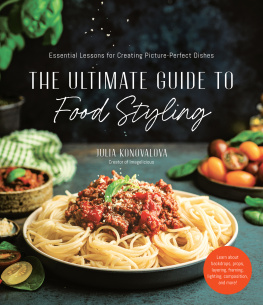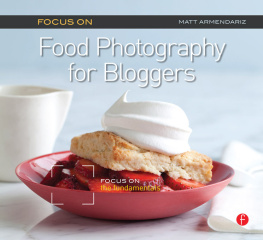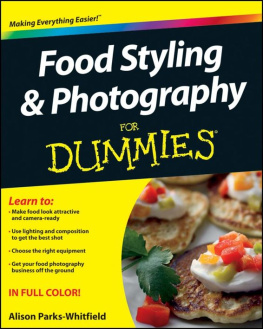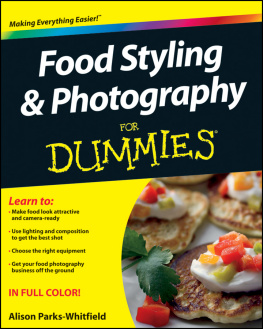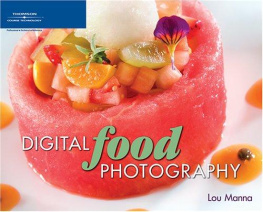Contents
Guide
MASTER THE ART OF FOOD PHOTOGRAPHY
WITH 52 BITE-SIZED TUTORIALS
PICTURE
PERFECT
FOOD
JOANIE SIMON
Creator of The Bite Shot

The author and publisher have provided this e-book to you for your personal use only. You may not make this e-book publicly available in any way. Copyright infringement is against the law. If you believe the copy of this e-book you are reading infringes on the authors copyright, please notify the publisher at: http://us.macmillanusa.com/piracy.
+ TO THE VIEWERS ON YOUTUBE:
YOU ARE THE BEST AUDIENCE EVER. THIS BOOK WOULD NOT EXIST WITHOUT YOUR SUPPORT.
My husband, Ryan, and I moved from our hometown of Phoenix, Arizona, to New York City in the summer of 2007. Three weeks after our wedding, we were in a moving truck crossing the George Washington Bridge filled with nervous excitement about the big, wild adventures ahead. We settled into new jobs, a new neighborhood, made new friends and, most importantly, discovered new food.
Ryan worked in a foundry, and I was working at a school. We werent making much money, but the money we had went toward culinary experiences. We explored the local restaurants and markets, taking suggestions from friends on the best places to eat. We ate our way across the city, accumulating new favorites like the gargantuan chocolate chip cookies at the bakery around the corner from our apartment, the savory lapsang souchong-infused scones from the little breakfast joint on 86th Street and the piping hot soup dumplings on Pell Street in Chinatown.
Around that same time, I started to cook more adventurously in our tiny apartment. I had a kitchen full of cookware gifted to us from our wedding and was inspired by the variety of ingredients at the local markets. Between dining out and cooking at home, New York City inspired me, and I wanted to share it with everyone back home. So, I set up a blog, bought a pink point-and-shoot camera and posted on my website photos of what I was cooking and eating. That first food blog was the start of what would eventually become my career in food photography.
For the record, those early photos were terrible. But I had the one thing that I believe you need in order to create great food images: a love of food. I also had something that Im sure you have, too. I had a vision in my minds eye for how the photos should look. I wanted the food to jump off the page, to convey that the dish was delicious. It took years of hard work for those visions in my mind to be present in the images coming out of my camera. So, as you take steps on your own photography journey, be patient with yourself and your work. The things most worth doing wont come easily. Food photography is more than lining up your camera in front of a dish of food and hitting the shutter button. Its a myriad of creative decisions coming together to create an effective image.
The good news is that your journey can move quicker than mine. The pages of this book are filled with the important lessons that moved my skills forward during that difficult period between falling in love with food photography and feeling confident behind the camera. I will lead you through 52 lessons and challenges, one for each week of the year. These chapters will deepen your understanding of camera settings, lighting, storytelling, composition, food styling, props styling and finding inspiration through applied learning. After all, experience is the best teacher. I recommend having a notebook and a pencil handy for reflection and note-taking to cement your learning. I frequently use a notebook to plan my shoots, so this will become a helpful tool beyond the exercises in this book. The activities here are suited for any kind of camera, from phone cameras and point-and-shoot to DSLR and mirrorless cameras. No matter the camera you have, take the time to learn it inside and out.
Many of the lessons also include images I captured for this book. Feel free to re-create these images, especially if food photography is new for you. I tried on the styles of other photographers until my work evolved into what felt like an aesthetic that was uniquely mine. Experimentation helps you uncover your own authentic voice and perspective. And as you work through the activities, share your work online and use #pictureperfectfood to connect with your fellow readers on social media.
Whether youre capturing food for the pure enjoyment of the experience, youre working hard to launch a food product into the marketplace or you want to get more eyeballs attracted to your food blog, food photography is a fun and fulfilling craft. I am thrilled to have the opportunity to be your teacher and wholeheartedly believe in your ability to master these skills.
Want to enjoy more food photography education? Join my Insider List at joaniesimon.ck.page/picture-perfect
+ SOME NOTES ON PHOTOGRAPHY GEAR
The most frequently asked questions I receive are in regard to gear. Cameras, lights, accessories, phone vs. DSLR vs. mirrorless, etc. The blessing and curse of our modern photography era is that we have an unbelievable and ever-expanding number of options when it comes to gear. The good news is that you cant make a wrong decision. The best option is always to start with what you have. Once you have a firm grasp and command over your existing tools, then you can invest in additional gear based on your needs.
But most importantly, if you dont take anything else away from this book, I want you to know that a better camera will not give you better photos. Its like asking a baker which brand of oven they use to make their impossibly flaky, buttery pie crust. The oven is far less important compared to the skills of the baker. The real magic in any craft is the result of combining creative instincts with thoughtful practice. Save your money and invest your time in learning instead.
+ My first camera!
+
Cameras are powerful. They enable us to share the visions in our heads with the press of a button. F-stops and shutters do more than simply expose an image. The creative applications for camera settings are endless. Lets start our photographic journey with understanding and applying the essential camera settings, then explore how they can be used with artistic intention. These will be the most technically complex concepts in the book, so if you can wrap your mind around these lessons, youll have an excellent foundation on which to build your photography skills.

This is where it all starts. You introduce light and shadow to a subject and press a button to capture an exposure that is rendered on your LCD screen as an image. Per definition, in digital photography, the exposure is the amount of light that reaches the cameras sensor to record the image. I imagine the light particles traveling through the lens, into the camera, burning themselves onto the surface of the sensor inside and recording all the details of what was light and what was shadow down to the last detail.


